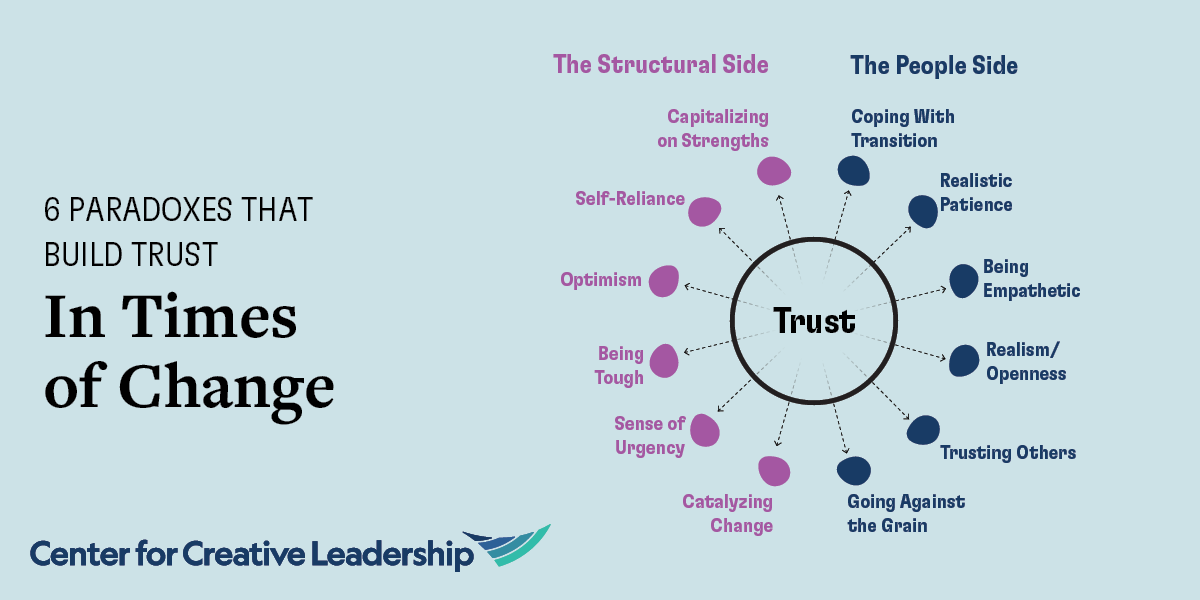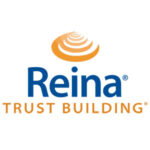The pace of change that organizations face today has moved into overdrive. Leaders must be prepared to adapt to continuous disruption, and to lead their teams in new and innovative ways.
Whether it’s leading a group of people in an office setting, managing teams remotely, or more likely, leading a hybrid workforce, it’s critical for leaders to build and maintain trust with their people.
Leadership trust creates the stable foundation for employees and their organizations to flex, adapt, and thrive in times of continuous change.
The behaviors that build trust are the very behaviors that manage change. Trust building helps teams step into ambiguity, stay committed to managing the unknown with confidence, and embrace change as an opportunity to learn, grow, and do great work together.
What Is Leadership Trust?
Trust means “uncompromised by doubt.” In the workplace, people can’t do their best work if they doubt others’ intentions or capabilities, the direction or viability of the organization, or, most importantly, if they doubt their own ability to keep up with the demands placed on them. This is especially true in today’s environment of complex change and ambiguity, when employees are being asked to do more with less.
Leadership trust is reciprocal and created incrementally. To inspire trust from others, leaders need to also show trust in them. Over time these relationships build and maintain the trust that teams and organizations need to take action in a fast-paced world.
Our research underscores the need for trust in organizations. In high-trust environments, people show up and to do their best work. They gain productive energy, creativity, speed, and better results. They align around a common purpose, take risks, support each other, and communicate openly and honestly.
Effective leadership requires knowing how to build and keep trust, whether it’s with individuals, on teams, or across the organization.
How to Build Leadership Trust
Address Both Sides of the Change Equation to Maximize Leadership Trust
Leading effectively, especially in times of disruption, requires the ability to build leadership trust in challenging environments. Within organizations, change happens on 2 sides:
1. The structural side.
The structural side of change includes new external realities and the business system and process changes needed to address them, such as an organizational restructure in response to a global pandemic.
2. The people side.
The people side of change includes the internal, psychological transitions people go through to adjust mindsets, behaviors, and culture to new realities and business processes.
To address the structural side of change, leaders need to leverage strengths and create commitment across the organization.
And to address the people side of change, leaders must connect with people emotionally, recognize where they are in the transition process, and model resiliency, curiosity, and compassion.
Leadership trust is built by balancing these 2 sides of the change equation along very specific lines that often feel like paradoxes.
Balancing Paradox to Build Leadership Trust
Because Leadership Isn’t Either/Or, It’s Yes, And
Leadership often comes with choices that have no right answers.
For example, in the midst of organizational change, should leaders communicate a sense of urgency to take action, or patience with people’s need to understand and adapt to the change? Should they project a sense of optimism, or a realistic view of the challenges ahead?
The reality is, today’s leaders cannot afford to only choose one or the other. Building leadership trust and moving forward together relies on both. This is the crux of a paradox, also known as a polarity: it requires the ability to see both perspectives clearly and at the same time — and to build trust while balancing those perspectives.
Leaders cannot afford the simplicity of either addressing the structural side or people side of change. They can only advance change objectives effectively by focusing, instead, on “yes, and” approaches.
The leaders we work with in our programs have faced an incredible amount of disruption over the course of the pandemic — to both their personal and professional lives. While exhausted, they know they need to continue to move the needle for their organizations in the face of this upheaval.
To do so, these leaders need to be able to rely on their teams and move quickly, which requires trust. Teams move at the speed of trust — and whole organizations move at the speed of their teams.
This is one of the many “yes, and’s” of leadership.
Manage These 6 Paradoxes to Build Leadership Trust
Our research has found 6 critical paradoxes to balance to build and maintain leadership trust.
Participants in our Leadership Development Program (LDP)® explore these paradoxes through our “Leadership Paradox Wheel” tool. This tool helps leaders recognize the tensions they face, and how they might build stronger trust by highlighting one end of the paradox or the other at specific times, while always leading with both in mind.
For example, structural changes require a sense of urgency to move things forward, while people need realistic patience as they transition their mindsets and adapt to new conditions and processes.
Leaders lose trust when they ignore or overplay either side of this equation. A leader may be seen as lacking empathy and patience if they push too quickly toward change. Alternatively, if a leader is overly patient but lacks urgency, change may stall, causing them to lose credibility.
Either imbalance breaks trust in leadership; people count on leaders to deliver business results and care for those they lead.
Building Leadership Trust: A Collaborative Effort
In a recent study we conducted of more than 140 top leadership teams, team members reported greater psychological safety at work when they regularly shared information and developed relationships of mutual influence with others. Interpersonal trust, information sharing, and mutual influence increases overall group psychological safety — a key driver of team performance and innovation.
But what does trust mean in the context of leadership? Trust is a complex concept, and it means different things to different people. Talking about trust and establishing shared definitions are key steps to address trust across a team or organization.
A shared understanding and language to talk about the specific behaviors that affect trust can result in more productive conversations about team performance. Those conversations can even create stronger bonds between leaders and employees.
But leadership trust isn’t a one-off initiative. It requires continued effort from all team members. And it takes leaders who are willing to show integrity, change behavior, and take on the hard work of collaborating across boundaries and dealing with differences.
Research shows that trust represents a core human need we all have: to trust others, to be trusted in return, and to trust in ourselves. When trust is present, people align around the purpose of their team, embrace goals and objectives, willingly collaborate, and are empowered to do their best work.
When trust is absent, or made vulnerable, work becomes more difficult and takes longer to execute. With the pace of change in today’s organizations, leaders need trust more than ever before.
Building leadership trust amidst change and continuous disruption is a key element in our flagship Leadership Development Program (LDP)®. The longest-running program of its kind in the world, LDP is designed for managers in the middle — those who rely heavily on leadership trust to build commitment and translate strategy into effective action.
Participants of LDP examine their own leadership styles so they can develop a more balanced approach, foster authentic connections, and collaborate across all levels of the organization to produce results — even in the midst of unprecedented change.
Ready to Take the Next Step?
Give your people the skills needed to build leadership trust with their teams with our Leadership Development Program, available both in person and online.










